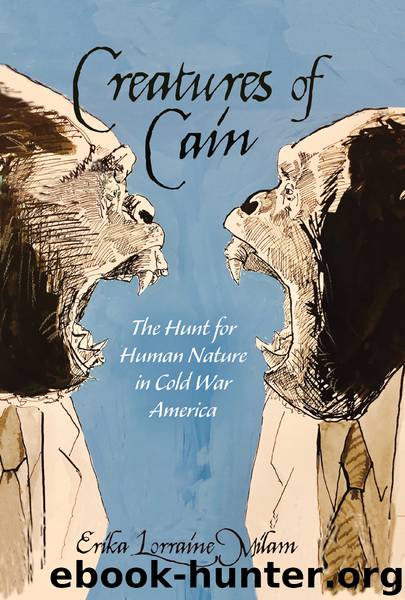Creatures of Cain by Milam Erika Lorraine

Author:Milam, Erika Lorraine
Language: eng
Format: epub
Publisher: Princeton University Press
Published: 2018-10-08T16:00:00+00:00
FIGURE 25. Resistance to secular humanism gathered steam in the following decades. Here, Tim LaHaye illustrates the three platforms of humanism—amorality, evolution, and atheism— resting on the work of (from left to right) Aristotle, Socrates, Plato, Voltaire, Rousseau, Gibbon, Weishaupt, Feuerbach, Paine, Nietzsche, Hegel, Huxley, and Russell. The supportive pillars of Christianity, however, came instead from reading Genesis, law, history, Job, Psalms, the prophets, Gospels, Acts, Epistles, and Revelation. Image: Tim LaHaye, The Battle for the Mind (Old Tappan, NJ: Fleming H. Revell, 1980), 80. Courtesy of the LaHaye Family.
In retrospect, the debates over MACOS amplified concerns about secular humanism within an increasingly visible evangelical community. Legal wrangling continued, too, and in 1979 Conlan coauthored an article in Texas Tech Law Review with John W. Whitehead in which they expanded the logic of earlier reactions against MACOS into formal argumentation, this time with no reference whatsoever to the program.102 During his 1980 campaign for president, the former governor of California Ronald Reagan deemed it expedient to repeat old arguments against MACOS, suggesting that the curriculum “indirectly taught grade school children relativism, as they decided which members of their family should be left to die for the survival of the remaining ones.” Characterizing MACOS as a secular humanist curriculum, he added, “I don’t recall the government ever granting $7 million to scholars for the writing of textbooks reflecting a religious view of man and his destiny.”103 After his election, Reagan’s administration dismantled the NSF education directorate entirely, and for many scientists who had paid attention to the MACOS affair, the fate of the program “contributed materially” to that outcome.104 In the coming decade, Conlan and Whitehead’s use of “secular humanism” became a cornerstone of arguments for giving “equal time” to creationism and evolutionary thought in public schools.105 Tim LaHaye, a San Diego preacher and founding member of the Moral Majority, promoted a crusade against “secular humanism” through writings like Battle for the Mind and the Left Behind novels (Figure 25).106 Secular humanism again cropped up in many of the other classic evangelical texts of the period, including books by Jerry Falwell, Francis Schaeffer, and Phyllis Schlafly.107
Through the lens of these later heated debates, it now seems remarkable that anthropologists and psychologists in the mid-1970s were flummoxed by the storm brewing around them. By never referencing evolution in the narrow sense, MACOS designers believed they had protected themselves. Yet conservative textbook watchers worried over the express cultural relativism of scientific depictions of human nature. Bruner and DeVore seem to have believed this was a political, not scientific, battle and that the influence of the “anti-intellectual hounds” (as Bruner had termed them) would never impinge on their professional lives. This stance makes sense only if one considers the raucous campus radicalism of the late 1960s and early 1970s. Evolutionary anthropologists and biologists ignored the oratory flourishes of congressmen in order to concentrate on divisive activism flaring up within the academy, much closer to home.
Download
This site does not store any files on its server. We only index and link to content provided by other sites. Please contact the content providers to delete copyright contents if any and email us, we'll remove relevant links or contents immediately.
Enlightenment Now: The Case for Reason, Science, Humanism, and Progress by Steven Pinker(7228)
A Journey Through Charms and Defence Against the Dark Arts (Harry Potter: A Journey Through…) by Pottermore Publishing(4781)
The Immortal Life of Henrietta Lacks by Rebecca Skloot(4525)
A Journey Through Divination and Astronomy by Publishing Pottermore(4344)
Elon Musk by Ashlee Vance(4028)
Origin Story: A Big History of Everything by David Christian(3648)
COSMOS by Carl Sagan(3554)
Alchemy and Alchemists by C. J. S. Thompson(3449)
Bad Pharma by Ben Goldacre(3355)
Enlightenment Now by Steven Pinker(3337)
Shadow of Night by Deborah Harkness(3302)
Inferior by Angela Saini(3276)
A Mind For Numbers: How to Excel at Math and Science (Even If You Flunked Algebra) by Barbara Oakley(3217)
Origin Story by David Christian(3147)
The Code Book by Simon Singh(3074)
Signature in the Cell: DNA and the Evidence for Intelligent Design by Stephen C. Meyer(3071)
The Elements by Theodore Gray(2998)
A Brief History of Time by Stephen Hawking(2960)
A Journey Through Potions and Herbology (A Journey Through…) by Pottermore Publishing(2826)
